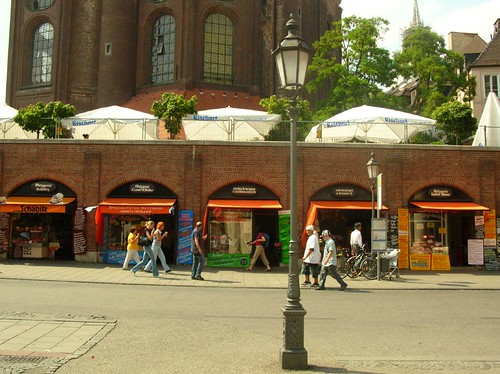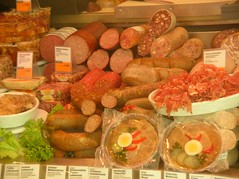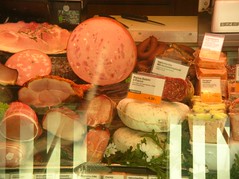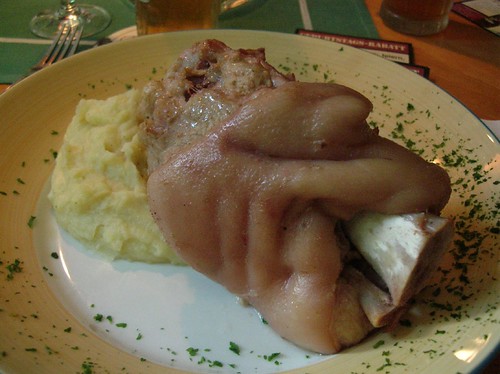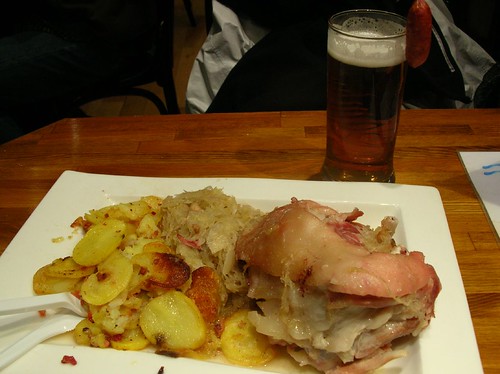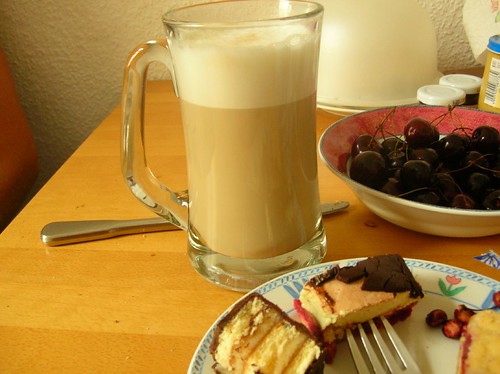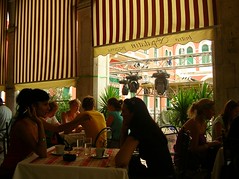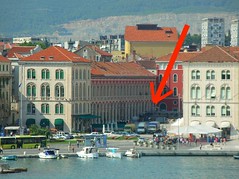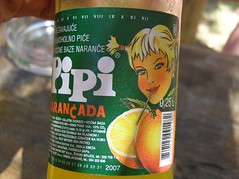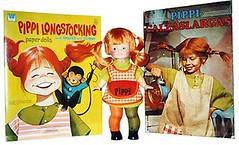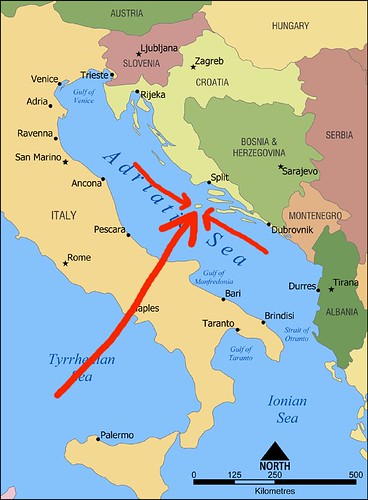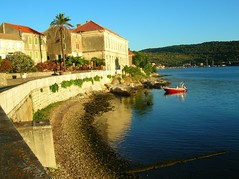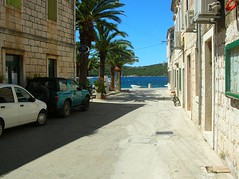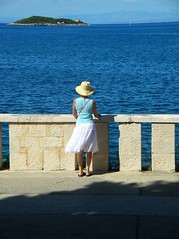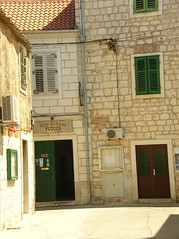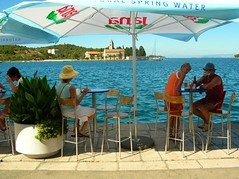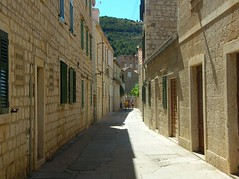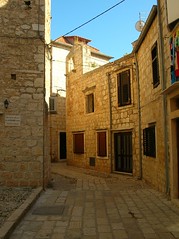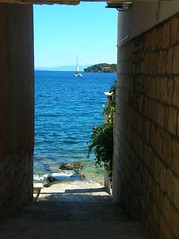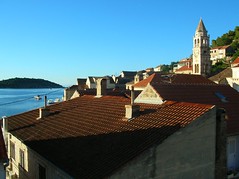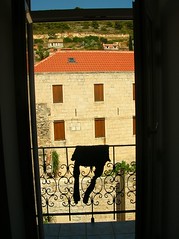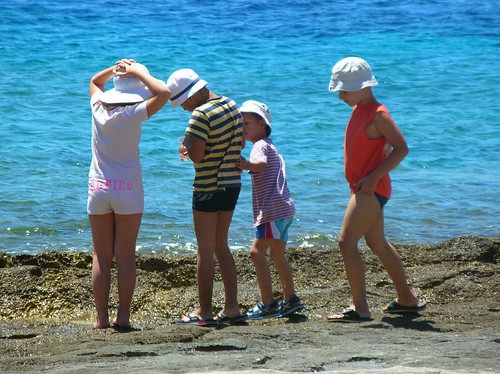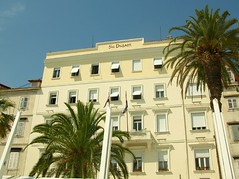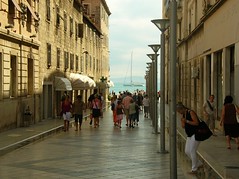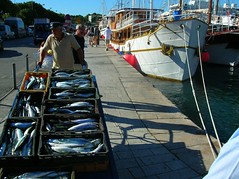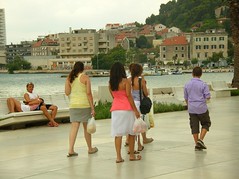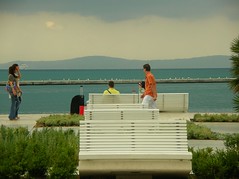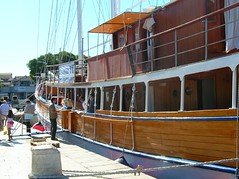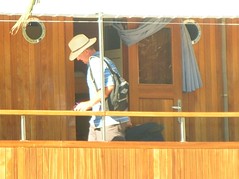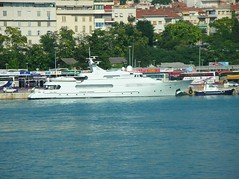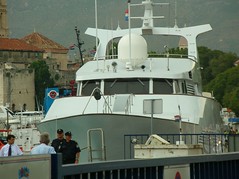Tuesday, July 31, 2007
Vive la difference
Starbucks U.S. merchandizing scheme apparently translates pretty directly into the German marketplace. There are few immediately noticeable differences in the look of the place or the offerings, right down to the "Tall, Grande, Vente" sizes -- Starbucks' own international language of the $4 cup of coffee.
I couldn't bring myself to set foot in a McDonald's, but from quick outside pass-bys, it seems to be basically the same in Germany as in the U.S.
Dunkin Donuts is a different story, however. The many Dunkin's around Berlin offer a selection of donuts presumably adapted to German tastes. In contrast to the "shades of brown" expectations of U.S. consumers, German Dunkin goes tutti fruity, both in color and flavor, even as they deploy mostly English in the point-of-sale display.
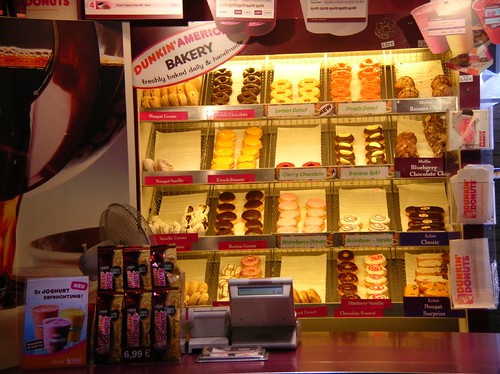
Dunkin Donuts, Friedrichstrasse S-Bahnhof, Berlin.
Lemon, peach, cherry, cherry-banana, banana split, pink, orange, red. Who came up with these?
I couldn't bring myself to set foot in a McDonald's, but from quick outside pass-bys, it seems to be basically the same in Germany as in the U.S.
Dunkin Donuts is a different story, however. The many Dunkin's around Berlin offer a selection of donuts presumably adapted to German tastes. In contrast to the "shades of brown" expectations of U.S. consumers, German Dunkin goes tutti fruity, both in color and flavor, even as they deploy mostly English in the point-of-sale display.

Dunkin Donuts, Friedrichstrasse S-Bahnhof, Berlin.
Lemon, peach, cherry, cherry-banana, banana split, pink, orange, red. Who came up with these?
Monday, July 30, 2007
So pointless... it wasn't even exclusive coverage
I refer of course to Saturday's tragically ironic story of the collision of two news choppers while filming a police car chase.
What's the lesson here? Please take the following internet poll with your interpretation:
Can the fleeing felon in the underlying car chase be charged with murder for the four journalist deaths under the "felony murder rule"?
What's the lesson here? Please take the following internet poll with your interpretation:
1) The journalist always becomes the story.Now, a question for all you legal eagles:
2) What won't they do to generate a headline on a slow news day!
3) Bad karma catches up to "if it bleeds, it leads" journalism.
Can the fleeing felon in the underlying car chase be charged with murder for the four journalist deaths under the "felony murder rule"?
I'm baaaack!
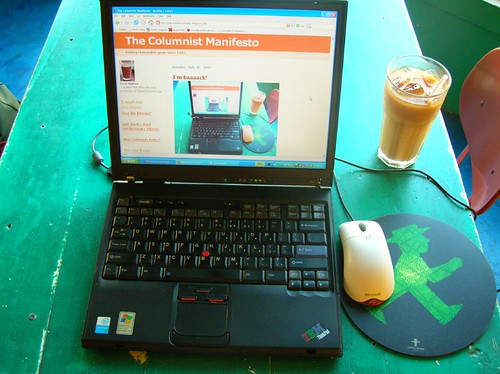
Not to get all greeting-card on you or anything, but one of the great things about a long trip is returning to an emotional wave of how much you love where you live. (If you do. I do.)
Here I am, depicted iconically, at my favorite table at Grandma Moses. Note my one travel souvenir: an Ampelmann mousepad.
Lots of catch-up travelblogging still to come... stay tuned!
Sunday, July 22, 2007
Kino

I love the word “Kino.” To me it suggests an engrossing foreign intrigue. It means “cinema,” not only here in Germany, but in other middle and eastern European countries – Poland, the Czech republic, and I don’t know where else. It’s an international word that’s not English.
I’m a firm believer in visiting the kino when traveling abroad. It’s interesting to see a familiar cultural experience twisted 60 degrees off kilter.
The differences can be a hoot. I particularly recommend seeing comedies, so you can hear what the native residents laugh at. I’ll never forget seeing Woody Allen’s “Everything You’ve Always Wanted to Know About Sex (But Were Afraid to Ask)” in Britain. In a pretty full theatre, I was the only person who laughed during the Italian-movie parody sequence when Allen says (in Italian, with English subtitles), “when we have sex, my wife lies there like a lox!”
In Germany, most foreign films are dubbed, but a handful of theatres catering to hard-core film-buffs (and English-speaking tourists) offer an “Originalversion.” So B and I went to see “Ocean’s Thirteen” in the Englishe Originalversion at the Sony Center "Cine Star" multiplex at Potsdamer Platz.
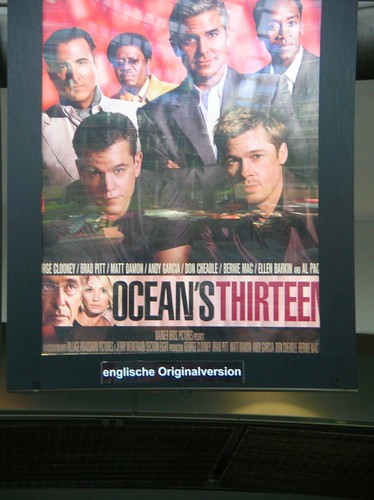
On our first attempt, a Sunday matinee, we arrived just a minute or two before showtime, but we figured there would be several minutes of commercials and trailers, so that we wouldn’t miss the beginning. The ticket lines were long, but I estimated we’d have our ticket in five minutes – plenty of time.
But I was applying time-motion study experience from American movie theatres. Here, the tickets were sold at a counter that looked like one set up for serious, involved transactions. Twenty yards or so long, staffed with half a dozen or more seated ticket sellers with two head-setted managers moving fussily behind them, answering phones and trouble-shooting, the ticket counter looked like a bank or a busy inter-city train station.
How slowly did the line move? Slow enough that the customers being served crossed their legs and leaned on the counter, airport style. Ticket purchase took, on average, a minute. That may not seem long, but do these two mental operations: (1) look at your watch for a minute while imagining buying a movie ticket in the States. (That’s right, it normally takes us Americans about 10 seconds – 15 if you banter with the ticket seller.) (2) Multiply the minute by the 15 people in front of us.
I quipped to B, “Do you think they’ll ask for our passports? I didn’t bring mine!” B replied, “We’re going to miss the beginning. Let’s leave.”
On our second attempt, a Friday night, a crowd of people were lined up halfway across the Sony Center. It turned out, though, that they were lining the man-ropes along a red carpet (in Germany, more of a heavy white construction paper) to see some B-list American Celebrity who was to show up for some sort of premiere thing. Jessica Alba, we were later uncertainly told.
The ticket lines were short – there were twice as many ticket sellers as before – and we breezed in early, the first ones in the theatre. While B and I often dither about where to sit in an empty theatre, here would couldn’t, because this theatre sells assigned seats.
There were 15 minutes of ads and trailers, followed by a short break. (We may well have made it the last time!) German moviegoers know this, so they purposely arrive late: the theatre only started filling up as the ads and trailers were rolling.
Memo to Robert Redford and his new Sundance Cinema concept: it is extremely annoying and needlessly anxious-making to have assigned seats in movies. I counted at least half a dozen disputes over who was in the right seat in the semi-darkness of the flickering screen, and for the first five minutes of the film I kept expecting someone to tap me on the shoulder and claim my seat.
I’m glad we didn’t miss the ads. They’re well made and visually clever (I couldn’t understand the language, of course), and I particularly enjoyed one about AIDS prevention in which a 20-something couple is involved in tasteful R-rated foreplay while two individually-wrapped condoms – animated in the style of the Pixar film “Cars” – keep up a snide running commentary.
After an ad for Ben & Jerry’s ice cream, featuring “Cherry Garcia,” the house lights came up and in walked a vendor with a box strapped to his shoulders, baseball-stadium fashion, full of – can you guess? – Ben & Jerry’s. He hawked his wares by calling out the American flavor names: “Cherry Garcia”, “New York Fudge Brownie.” I particularly liked his germanicized version of “Chunky Monkey” in which he rolled over the k’s with a quick, hard “g”– “Chungy-mungy,” like it was a single word with the accent on "chung." I wondered whether the Germans would get the great pun behind Cherry Garcia, especially since they tend to pronounce “Jerry” by saying “Cherry” anyway. As in “Ben & Cherry.” And do they know that we “Ami’s” used to call the Germans “Jerries?” My mind began spinning.
The house lights went off again, and the ads resumed with one for beer. I wondered whether they’d stop again after this one so that a beer vendor could enter the theatre. No such luck. Most people had gotten their beer already, at the refreshment stand.
The movie finally began. “Ocean’s Thirteen” is perfect light entertainment for an expat feeling the first tugs of homesickness. You get to see many of your favorite American movie stars as you admire the slick Soderburgh Ocean franchise that, improbably, still works in its third iteration.
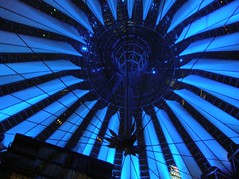
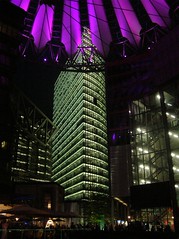
Sony Center, Potsdamer Platz, Berlin.
Only about halfway through did I notice that the “Englishe Originalversion” did not even have German subtitles. The mostly-German spectators were so fluent in English that they followed the dialogue without language aids, laughing at most of the jokes to boot. Most, but not all. They missed a few, including (perhaps especially) Matt Damon’s lascivious line to Ellen Barkin, “perhaps you should ask Mr. Wang yourself.”
After the movie, it was a perfect summer night at the Sony Center, warm and breezy with festive lighting and plenty of seats by the fountain where you could people watch – and get free WiFi.
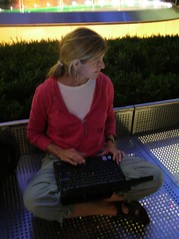
Saturday, July 21, 2007
The sausage test
At the Viktualienmarkt in Munich. Each of these five shopfronts is a different butcher.
With a wide-angle lens, I'd have gotten a few more in this shot.
With a wide-angle lens, I'd have gotten a few more in this shot.
During the Ardennes battle in December 1944 (aka the Battle of the Bulge), a German commando unit infiltrated American lines in captured U.S. vehicles wearing American army uniforms. German soldiers fluent in unaccented American English were recruited for the purpose. News of this infiltration, augmented by rumor, spread during the battle and caused a lot of panic.
As made famous in war movies, American MPs developed impromtu tests to distinguish friend from foe, basically quizzing suspected infiltrators on American trivia ("who plays shortstop for the Brooklyn Dodgers?" and the like.)
I was put in mind of this recently standing in front of a sausage counter in a Munich butcher shop. Like the French with their cheeses, so the Germans with their cold cuts and sausages: it seems that every village in the entire country has developed, over the centuries, its own special brand. The array of sausages and cold cuts is so bewildering that it would take years of study to master and at least several months to develop a working knowledge.
This would have been an effective way for the Germans to have exposed a non-German infiltrator during the war. "You will now look at these cold cuts and name them, please!"
Friday, July 20, 2007
The "Kaffee und Kuchen" diet
After a couple of weeks of eating delicious but heavy German food, you start to feel full most of the time. But necessity is the mother of invention: I now unveil the "coffee and cake diet," which I will keep to for most of the rest of my stay in Berlin.
The coffee and cake diet is simple: eat a big meal early in the day -- a breakfast buffet, brunch, or a large early lunch -- followed by coffee and cake in the late afternoon. You're set until bed time!
This nutritional regimen received a big boost when our German friends gave us their national secret of how to make latte. It depends largely on a special milk steamer and a few tips for knowning when the milk is done. And voila -- professional, cafe-quality lattes in your own kitchen. (Pictured below with take-out cakes.)
Heavy, but delicious, German food. Above and below: two versions of the German specialty called "eis bein," a cured and roasted pork knuckle. Note the "cocktail sausage" charmingly hung at the edge of the beer glass, below.
The coffee and cake diet is simple: eat a big meal early in the day -- a breakfast buffet, brunch, or a large early lunch -- followed by coffee and cake in the late afternoon. You're set until bed time!
This nutritional regimen received a big boost when our German friends gave us their national secret of how to make latte. It depends largely on a special milk steamer and a few tips for knowning when the milk is done. And voila -- professional, cafe-quality lattes in your own kitchen. (Pictured below with take-out cakes.)
B's home-made decaf soy latte, using the secret German technology.
Thursday, July 19, 2007
No Coke... Pipi!
In Split, we had lunch on this lovely piazza while waiting for our ferry.
In one of those "life imitates art, amost but not quite" moments, I ordered a "Coca-cola" and was given a bottle Pepsi. What was disappointing to me was not the switcheroo, but rather the failure of our Slavic waiter to say, "No Coke... Pepsi!" (For those of you too young to pick up the reference, it's John Belushi in the "Cheeseburger, cheeseburger, cheeseburger" skits on SNL.)
But my disappointment was fully redeemed a couple of days later, at a beachside cafe on Vis. I ordered an "Orangina," ubiquitous in European cafes, and the waitress said, "We do not have Orangina. We have 'Pipi.'"
Pipi -- a competing orange soda drink that appears to feature none other than Pippi Longstocking as its brand icon. Look at the pigtails!
Clearly, Pipi has grown up. Is it just me, or has Pipi turned out a bit ... slutty?
Our cafe, from our table, and from the Vis ferry.
In one of those "life imitates art, amost but not quite" moments, I ordered a "Coca-cola" and was given a bottle Pepsi. What was disappointing to me was not the switcheroo, but rather the failure of our Slavic waiter to say, "No Coke... Pepsi!" (For those of you too young to pick up the reference, it's John Belushi in the "Cheeseburger, cheeseburger, cheeseburger" skits on SNL.)
But my disappointment was fully redeemed a couple of days later, at a beachside cafe on Vis. I ordered an "Orangina," ubiquitous in European cafes, and the waitress said, "We do not have Orangina. We have 'Pipi.'"
Pipi -- a competing orange soda drink that appears to feature none other than Pippi Longstocking as its brand icon. Look at the pigtails!
Left: Pipi today. Right: as a youngster.
Clearly, Pipi has grown up. Is it just me, or has Pipi turned out a bit ... slutty?
Vis
We returned from Vis 10 days ago, so I'm catching up on a blogging backlog by posting about it now.
Vis was dreamy ... just what I wanted a Mediterranean island to be. Three days of swimming off of rocks and tiny beaches in unworldly blue water that is so bouyantly salty you can float without effort. Lying in the sun. Eating meals with lots of fish and olive oil (okay, and goat swimming in an inch of clear fat) at restaurants where the waiter brings you a platter of raw, whole fish and you discuss with him which one you'll have cooked up, as he picks each up in turn and brandishes it at you, estimating its weight.
The small seaside town with narrow cobbled streets, old stone buildings with terra-cotta roofs and heavy wooden shutters. The sun so hot that everything shuts down in midday and you have no choice but to take a siesta, keeping your shutters just a bit ajar to let in a glimmer of sunlight and cool sea breezes.
And vivid, unforgettable colors -- especially the range of blues -- that these photos just don't capture.
The egg-shaped island of Vis has a town at each end and a few villages dotting the rugged inland parts. Its overall population is a few thousand, and far less than it was in earlier centuries.
The local inhabitants are very ambivalent about tourists. The town of Vis has only two hotels, the popular swimming areas are commercial under-exploited, and there is not a single sign pointing you to hillside cavern where Tito hid with his partisans for several months in 1943. On the other hand, though the nearby Croation island of Hvar, which has emerged as the chic alternative to the Greek islands, siphons off the majority of tourists, Vis gets its share. The waterfront is lined with restaurants and the jetty crammed with tourist's sailboats most of the week. The same babel of languages one hears in Split can be heard in Vis.
There is something vaguely unsettling about being a tourist there. Many Croatians seem to speak good English, but they seem begrudging about your presence there -- similar to my impression of the Poles. Is it a Slavic thing? A post-communism first-world/ second-world thing?
Or is it the fact that they only recently faught a bloody civil war? Miloje, our Serbian host, has been comfortable going to Vis only for the last three years and some of here family will not set foot there. In the last hundred years, the Balkans have seen more war, and more recently, than any other part of Europe, and contemporary Croatian nationalism openly harkens back to the Ustazi faction that in its day had sought an alliance with the Nazis.
I would not return there without having friends to visit, yet I am so glad I went.
Vis was dreamy ... just what I wanted a Mediterranean island to be. Three days of swimming off of rocks and tiny beaches in unworldly blue water that is so bouyantly salty you can float without effort. Lying in the sun. Eating meals with lots of fish and olive oil (okay, and goat swimming in an inch of clear fat) at restaurants where the waiter brings you a platter of raw, whole fish and you discuss with him which one you'll have cooked up, as he picks each up in turn and brandishes it at you, estimating its weight.
The small seaside town with narrow cobbled streets, old stone buildings with terra-cotta roofs and heavy wooden shutters. The sun so hot that everything shuts down in midday and you have no choice but to take a siesta, keeping your shutters just a bit ajar to let in a glimmer of sunlight and cool sea breezes.
And vivid, unforgettable colors -- especially the range of blues -- that these photos just don't capture.
The egg-shaped island of Vis has a town at each end and a few villages dotting the rugged inland parts. Its overall population is a few thousand, and far less than it was in earlier centuries.
The local inhabitants are very ambivalent about tourists. The town of Vis has only two hotels, the popular swimming areas are commercial under-exploited, and there is not a single sign pointing you to hillside cavern where Tito hid with his partisans for several months in 1943. On the other hand, though the nearby Croation island of Hvar, which has emerged as the chic alternative to the Greek islands, siphons off the majority of tourists, Vis gets its share. The waterfront is lined with restaurants and the jetty crammed with tourist's sailboats most of the week. The same babel of languages one hears in Split can be heard in Vis.
Above and below: Our hotel room windows and views from them.
There is something vaguely unsettling about being a tourist there. Many Croatians seem to speak good English, but they seem begrudging about your presence there -- similar to my impression of the Poles. Is it a Slavic thing? A post-communism first-world/ second-world thing?
Or is it the fact that they only recently faught a bloody civil war? Miloje, our Serbian host, has been comfortable going to Vis only for the last three years and some of here family will not set foot there. In the last hundred years, the Balkans have seen more war, and more recently, than any other part of Europe, and contemporary Croatian nationalism openly harkens back to the Ustazi faction that in its day had sought an alliance with the Nazis.
I would not return there without having friends to visit, yet I am so glad I went.
Wednesday, July 18, 2007
Feel free to use this as the name for your new rock band
The conversation with our German friends wound around to the subject of misapprehended song lyrics. You know the phenomenon: the singer enunciates the lyrics badly, so you painstakingly puzzle out what you think he’s singing, and you get it wrong. Or you hear the lyrics as a kid and, with your young person’s understanding and limited experience with the awkward or archaic phrasings of many songs, you fill in what seems plausible.
Well-known example, from Flashdance: “... take your pants off/ and make it happ-punn...”
What started us on this topic was a similar plausible mistake B and I heard while walking past the "Englisher Garten" in Berlin's Tiergarten. An outdoor garden party was being regaled by a German lounge singer doing American covers. He sang: "Sittin' at the top of the bay/ watching the way-aay-aves roll in..." Otis Redding is still big in Europe.
The mistaken lyrics conversation is difficult to have across a language divide. Inevitably, the bilingual folks say,
In fairness to me, my version makes sense – sense, that is, once one accepts the premise of the virgin birth. I mean, in her situation, who wouldn’t rightfully feel a wee bit proud?
Well-known example, from Flashdance: “... take your pants off/ and make it happ-punn...”
What started us on this topic was a similar plausible mistake B and I heard while walking past the "Englisher Garten" in Berlin's Tiergarten. An outdoor garden party was being regaled by a German lounge singer doing American covers. He sang: "Sittin' at the top of the bay/ watching the way-aay-aves roll in..." Otis Redding is still big in Europe.
The mistaken lyrics conversation is difficult to have across a language divide. Inevitably, the bilingual folks say,
in the original German, the lyrics are supposed to be "floiner schpechh beloyten," but I always thought it was "floineh schpechh beluyrten,” which means “spank on the bottom.” So you see, it is very funny.But I learned something important in this conversation. Basically, I learned that the correct lyric to the English version of the Christmas carol “Silent Night,” is “round yon virgin mother and child.” Not, as I thought until just now, “proud young virgin mother and child.” At my age!
In fairness to me, my version makes sense – sense, that is, once one accepts the premise of the virgin birth. I mean, in her situation, who wouldn’t rightfully feel a wee bit proud?
Sunday, July 15, 2007
What are we doing in the great resorts of Europe?
B and I are in the south German resort town of Lindau, on the northeastern corner of Lake Constance, with beautiful views of the Austrian and Swiss Alps.
Here we are relaxing in old world elegance in the lobby of the Hotel Bayerischer Hof.
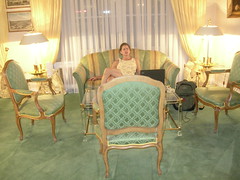
Doing what, exactly?
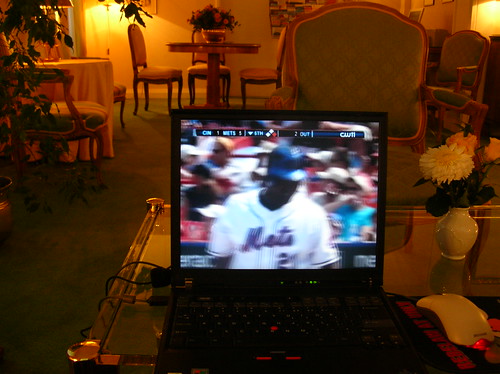
Here we are relaxing in old world elegance in the lobby of the Hotel Bayerischer Hof.

Doing what, exactly?

Saturday, July 14, 2007
Dinner at Darko's
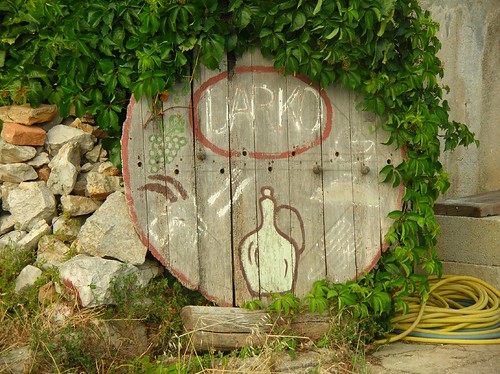
I feel compelled to begin this story near the end:
Maybe I should back up.... And so, having led his donkey into the restaurant, Darko fed it from a bowl, as the Slovenians at the next table looked on, laughing and pointing.
When our hosts, Miloje and Miroslav, told us that one dinner possibility was a “rustic” restaurant in a small village in the mountainous center of the Island – and that you had to call a day ahead and order goat or lamb (presumably so he’d have time to kill the animal?) – how could we say no? Plus, the guy’s name is “Darko.” How cool is that?
Darko runs apparently all operations of the restaurant himself ... and I mean all operations. He raises his own animals, and cooks them, makes his own wine and liqueur from grapes he grows himself, and makes salad and side dishes from home grown vegetables. He does his own baking. And he waits the tables.
The “restaurant” itself consists of a patio – probably the patio of Darko’s house – with four wooden picnic tables, two of which appear to be the sort of massive wooden spools used for coils of large wire, turned on their side. At one edge of the patio is a small shed which houses the oven and a larder. And the patio is covered with a bower of vines so dense that you feel like you’re indoors.

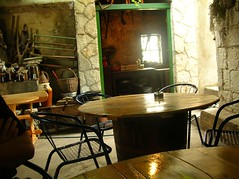
Left: the vinous roof. Right: the dining area, with cooking shed in the background.
Darko cooks the meat in a brick oven by covering a large metal dish full of meat with a metal dome and sliding it right next to the fire.
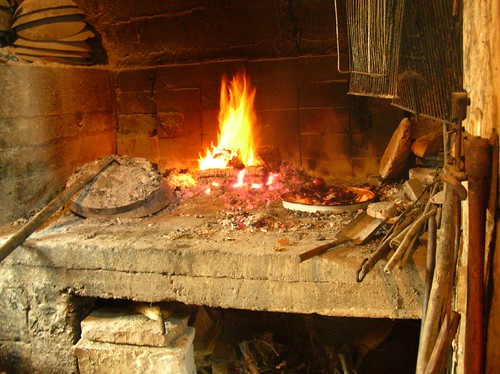
On the left side is the covering pan, on the right a dish of octopus pre-ordered by other diners.
And he seasons the meat simply, with “a little bit of salt,” pursuant to his theory that the flavor comes from the grass and herbs the animals feed on.
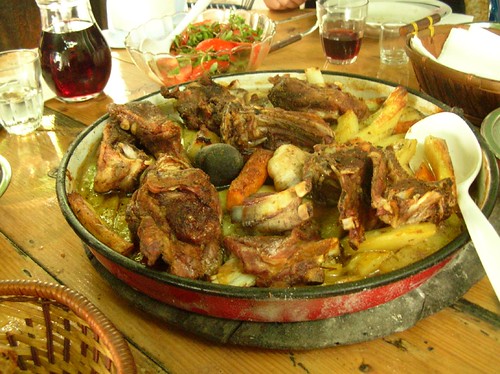
In the photo above, you can see the main course, which stuffed four adults. In the background, a pitcher of strong homemade wine proved crucial to cut through the "clear gravy" (see below). The round black thing in about the middle of the meat platter is a rock. Darko told us that (from the current vantage point) the lamb was to the left of the rock, the goat to the right. Why did he cook with a rock, Miroslav asked. Because, Darko replied, people always ask him about the rock and he gets a big kick out of that.
When Miloje and Miroslav had called to reserve a place, they asked Darko if it was okay to bring their dog. He said that would be no problem, so long as the dog wouldn’t mind his donkey, which, he promised, would bray “hee-haw” at us when we arrived. None of us could figure out whether Darko was kidding, and as it turned out there was no donkey to greet us. But when other guests arrived – the Slovenians, according to our hosts, who ID’d them by their dialect – we did hear the donkey braying.
The meat was incredibly good. I don’t know whether I preferred the lamb or the milder-tasting (!) goat. Or the potatoes. It was deliciously salty, and I couldn’t get enough of the almost clear gravy the meat was floating in, which I kept spooning over my meat and potatoes.
It was only when the demolished meat platter was removed that I realized that the clear “gravy” was actually fat, and that I may well have consumed about half a cup of clear, liquid fat in addition to what was already in the meat. Thinking back a few years to an unfortunate experience I’d had with barbecued ribs back in the States, I realized that the entire tone of the blog post I was already writing in my head hung in the balance, on the delicate question of whether I’d ultimately keep this food down. When I awoke at 5 a.m. the next morning, I found myself incredibly thirsty and with a meat hangover. But I was basically in one piece.
Darko, a curly-haired man in his late 40s or early 50s, looks like he’s “been through the wars,” and for a resident of former Yugoslavia, this could literally be true. He’s very jolly, and he bantered continually with our hosts, finding some occasion for a hearty laugh with each course.
At the end, he asked how we enjoyed the meal, and Miroslav said that everything was wonderful except that we were disappointed that the donkey did not greet us personally. Darko took this literally. Which brings me back to where this post began.

Thursday, July 12, 2007
Oscar Madison, industrial spy
While standing in the checkout line at Media Markt, waiting to purchase my new 20 euro photo-card reader, I snapped a quick photo. The cashier said:
Or was it a concern that maybe I'd reverse engineer the exceedingly clever gadget that was the subject of my photo. I photographed it because it was about as clever a bit of engineering as the hat with the beer-can holders and straws.
In fact, it was a remove control device with a bottle opener attached to the bottom. In other words, the Germans had managed to crack this very difficult engineering problem:
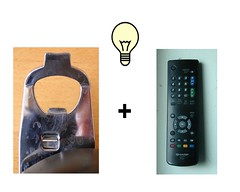
Unfortunately, I can't show you the photo of the actual device. When she said I had to delete it I meekly showed her my photo replay and was ready to delete it in front of her. But she muttered, "that's okay."
So I got to keep the photo. Only it was lost with all the others when my photo-disk malfunctioned.
I'd make a lousy spy.
"You're not supposed to take photos inside."Okay. My, but we're sensitive about ... what? The brilliant store layout, which looks like a bargain basement version of Best Buy? I realize that the look of the store's merchandise displays is proprietary, but please. As if the competition isn't sending around dozens of spies who get loads of info without obviously taking pictures.
"Oh, sorry," I replied.
"You must delete it."
Or was it a concern that maybe I'd reverse engineer the exceedingly clever gadget that was the subject of my photo. I photographed it because it was about as clever a bit of engineering as the hat with the beer-can holders and straws.
In fact, it was a remove control device with a bottle opener attached to the bottom. In other words, the Germans had managed to crack this very difficult engineering problem:

Unfortunately, I can't show you the photo of the actual device. When she said I had to delete it I meekly showed her my photo replay and was ready to delete it in front of her. But she muttered, "that's okay."
So I got to keep the photo. Only it was lost with all the others when my photo-disk malfunctioned.
I'd make a lousy spy.
Wednesday, July 11, 2007
Split
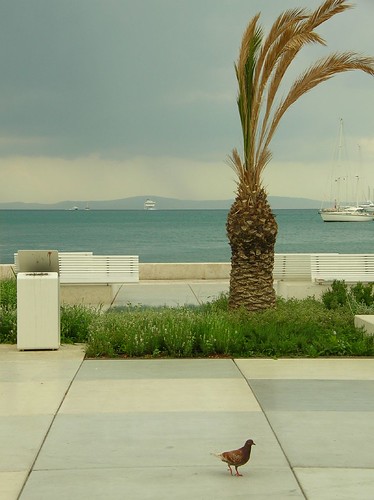
Our flight from Berlin went non-stop into the Croation port city of Split. From there we were to take a ferry to the Island of Vis, where our friends – a “mixed” couple, a Serb married to a Croat – were waiting for us.
It seems as though the strange weather in Berlin followed us, as a huge thunderstorm broke just as our airport bus set off on the half-hour ride to the harbor in Split. The roads were narrow and I wondered about safety, particularly when the driver turned fully around in his seat to tell one of the passengers to close the trap door in the roof, which was now letting in rain. Normally, I wouldn’t have thought much of it, except that the passenger didn’t speak Croation and the driver needed about 15 seconds worth of hand gesturing to make his point. Luckily, the driver had a crucifix hanging from his rear-view mirror, which protected us.
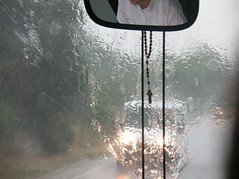
Split is a large industrial city – the second largest in Croatia I believe – but the harbor, on the edge of Split’s old town, comes straight out of one’s imagination of the small Mediterranean port. Stone buildings bleached white by the Mediterranean sun, set off with painted shutters. A long waterside promenade. Boats of every description.
In the Split harbor, one finds a Babel of international tourists. In addition to local Croats and other Balkan peoples, there are Austrians, Germans, Czechs, Slovaks, Italians, French, Brits, East Asians, and a fair number of Americans. Some of this you get from the languages and accents you hear, some from the look of the people, some from the car license plates you see around.
Split is the embarkation point for several Adriatic Islands, the most popular and trendy being Hvar, and you can even ferry to the eastern coast of Italy. It is also the source of numerous small steamship cruises and saiboat charters.
The steamships look charming at first glance, but lose some of their luster when you think ahead to what the trip would actually be like – cooped up in a confined space with a couple of dozen strangers. Fun for a day or two, but for more than that?
The sailboats, I believe, can be rented for sailing on your own, with larger skippered boats available for charter.(I can’t use the word “skipper” in this context without thinking of Gilligan’s Island.)
And then of course you see the occasional outrageous yacht. One, parked along the quay in split, was about 120 feet long and its Cayman Island registry bespoke massive amounts of money moved “offshore.”
“Your tax dollars not at work,” quipped B.
The outsized yacht club. Above, flying under the Cayman Islands flag.
Below: taking a good joke too far. Doesn’t it make you want to slap them...
with confiscatory taxation?
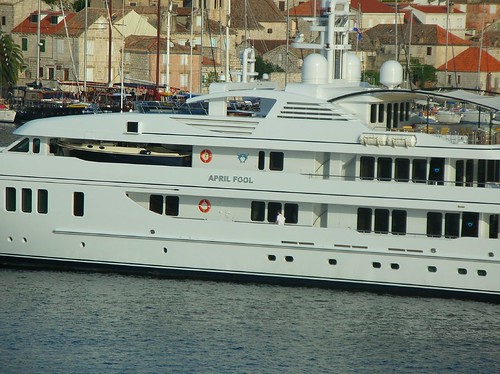
Below: taking a good joke too far. Doesn’t it make you want to slap them...
with confiscatory taxation?

I was particularly enthralled by the contrast between our relatively quiet Tuesday afternoon departure, and our Saturday morning return. Saturday morning is apparently when most rentals and charters begin, and the quays were filled with boats moored three and four deep.
Below: the same part of the quay, Tuesday and Saturday:
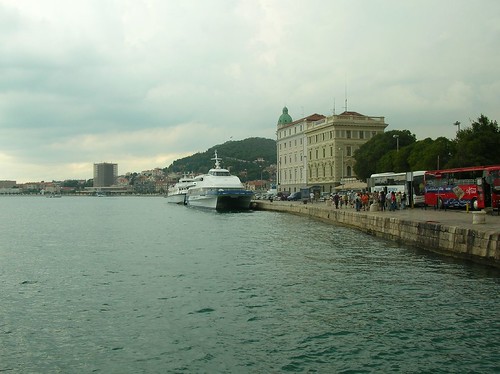
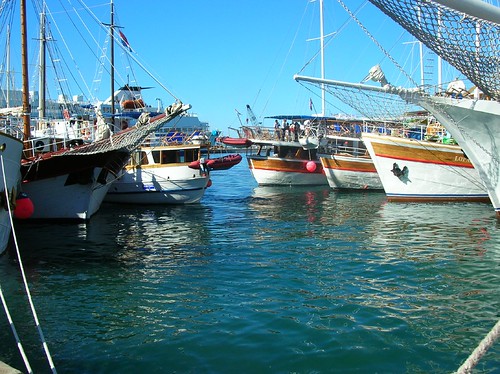
There’s a travel tip for Mediterranean ports: if you don’t like crowds, try to avoid Saturday mornings.
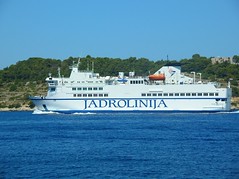
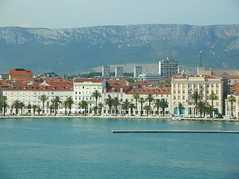
Above: Our ferry (I wasn't on it at the time) and the Split promenade (I wasn't on it at the time).
Below: arrival at Vis.
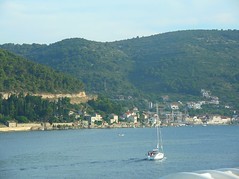
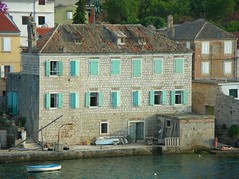
Subscribe to Comments [Atom]
